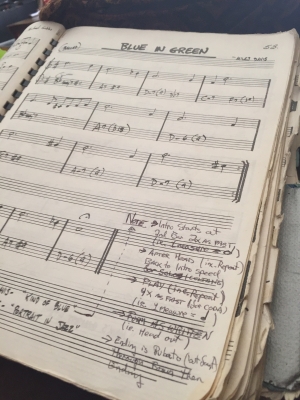Blog
Back >Jazz Studies
June 13, 2019
When I get a minute at home, I like to return to the lifelong study that is jazz.
One of my favorite tunes from the cannon is Thelonious Monks’ I Mean You. It’s a fun song - learned it (tediously) out of the original (5th Edition) Real Book, but then discovered that everyone likes to play the intro that was left out of this illicitly photocopied, hand transcribed ‘music.’ Anyhow, it probably took me several years to to figure out the intro, but I remember playing it a lot later when I lived in the Bay Area.
Anyhow, the 5th bar of the proper head (leaving aside the dilemma of the intro) has always been a source of consternation. It’s like the second line of the melody, repeating the initial phrase, which is clearly played over an F chord, as the real book says F6. The second time through this riff, then at bar 5, it says F with a parenthetic VI, II, V. Now this is a likely mistake in this book, (it was transcribed in a secret room under the practice space of ‘Till Tuesday, if you remember the 80s Boston pop act, it is obviously riddled with errors.) But they may have written an F just because it was the same riff.
Every jam I went to - generally house sessions, not public, we called them ‘Real Book Sessions’ because we all pulled out raggedy copies of the thing and immediately started making corrections. And then when someone would play an unfamiliar tune - well my procedure was to go find a version at the used record store and listen to one of the ‘greats’ Mile, Monk, Coltrane, et. al., play it. It took time but I could eventually follow along in the book with the records and correct some things on my own. I do remember after many, many listenings decoding the form of Blue In Green, as played vs. what's in the Book - whoo, I learned a lot.
But my obsession with Monk continues to reveal the mysteries of music, as I continue to study that 5th bar of I Mean You.
The song was apparently cowritten with Colman Hawkins, and he recorded it in ’46, but the first Monk recording of it is for Blue Note, 1948 with Milt Jackson on vibes, Shadow Wilson on drums, and I swear I hear bassist John Simmons play the F on bar five - but just on the head - they’re doing this big off-beat thing, and the piano is harmonizing the melody without root. The solos are for sure right on the G, right on the one of the measure - so that’s kinda wrong in the book, they should have written different changes for the solo . . . Anyway, if you check out the version from the ’63 Philharmonic Hall Concert the F on bar five is nowhere to be found - except inside a pretty rich chord, but that’s G minor7 right? - and dig that descending thing, like Gb, on beat four there, wow.
I mean it’s quite a contrast between the two versions, fifteen years later I guess. Music changed quite a bit in that time, and Monk was an architect. Interesting how his own designs reflect in the maturation of his own work. The voicing on the backup harmonies on initial solo chorus’ are magnificent. You have to listen carefully the backing harmonies are used sparingly throughout this collection, with some pretty long jams, this version is nearly thirteen minuets, and the Blue Note version 2:43.
Both versions, like all timeless jazz, hold a holographic image of the time and people who created it. Great songs, forms like this, let us express ourselves in the same hologram, in a structure that grows crystal-like but beyond the bounds of time. Lots have covered it, with at least three versions that include vocals. Man, I’m going to download the Art Blakey version, well, yea the whole record - I should maybe get this one in vinyl.
Keep celebrating and studying this music.
Portland OR, Sunny and Hot
